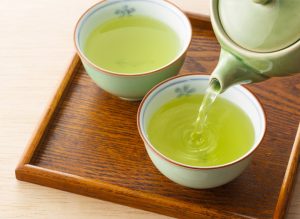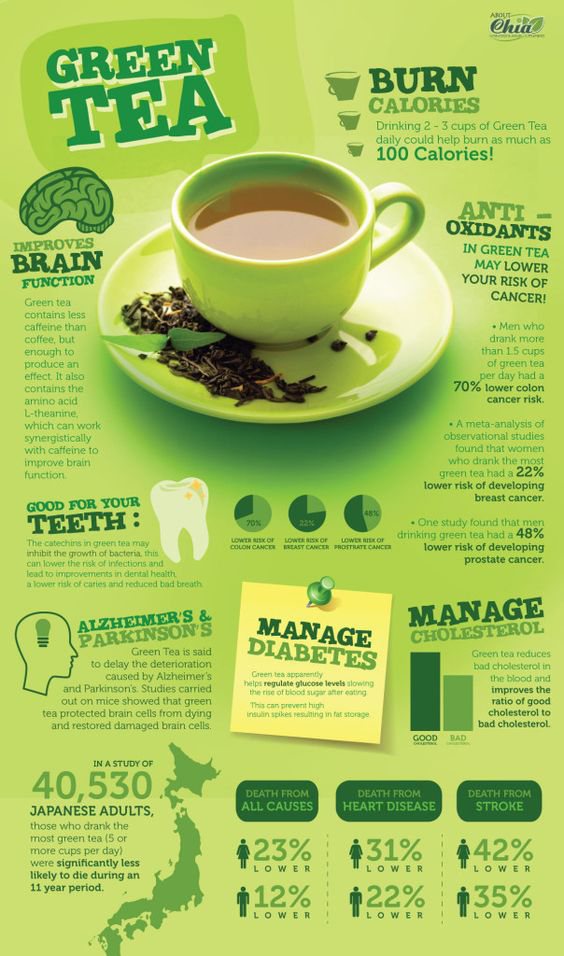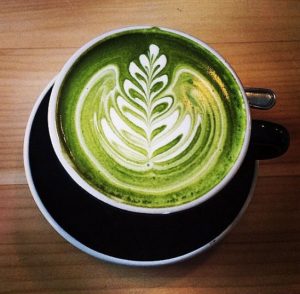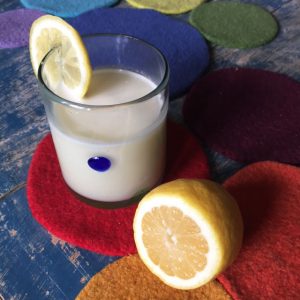One of the first books I read after getting my cancer diagnosis was David Servan-Schreiber’s Anticancer, which provided me with some ammunition to bring to the cancer fight. Servan-Schreiber, who died in 2011, was a French neuroscientist who was diagnosed with aggressive brain cancer at age thirty. Wanting to get some control over his fate beyond the medical realm, he did extensive research on complementary therapies and incorporated them into his routine, managing to live another twenty years. His book is a touchstone for countless cancer patients who would like to defy the statistics that come with their diagnosis.
 Servan-Schreiber strongly recommends green tea as a natural cancer-fighting force, and as a result I’ve been drinking it ever since. Initially I didn’t much like the taste, but now it has the familiarity of a good old friend, and hardly a day goes by without me drinking a cup or two or three—in fact, I’m drinking one as I type this.
Servan-Schreiber strongly recommends green tea as a natural cancer-fighting force, and as a result I’ve been drinking it ever since. Initially I didn’t much like the taste, but now it has the familiarity of a good old friend, and hardly a day goes by without me drinking a cup or two or three—in fact, I’m drinking one as I type this.
So what’s behind the hype? Is there a sound scientific basis for incorporating green tea into a cancer-fighting regimen?
The frustrating answer, as with so many nutritional protocols, is… “Maybe.”
As Servan-Schreiber writes, green tea contains polyphenols called catechins, one of which, epigallocatechin gallate or EGCG, has properties that could affect cancer growth and spread. When there’s enough of it in the body, EGCG settles on the surface of cells and blocks the signals allowing foreign cells (such as cancer cells) to penetrate neighboring tissue. It can also prevent angiogenesis, the creation of new blood vessels that cancer cells need in order to spread.
Servan-Schreiber cites public health studies from Japan, where green tea consumption is high, to bolster his case. In one study, for example, Japanese women who consumed three cups of green tea a day had 57 percent fewer breast cancer relapses than those who only drank one cup a day.
Sounds pretty good, right? So what’s the issue?
Well, to begin with, as this 2006 paper in Life Sciences indicates, EGCG has a “low oral bioavailability”—in other words, not much of it enters the blood stream.
Second, there are concerns about possible liver damage as a result of taking too much EGCG—though these have centered on green tea extract supplements rather than the drink. The European Food Safety Authority (EFSA) recently announced that it will look into the safety of green tea catechins.
Third, of course, epidemiologic (public health) studies are generally dismissed by scientists because they are not controlled for variables. In the Japanese green tea studies, for example, things like the subjects’ general health, their ways of preparing tea and the concomitant use of alcohol and tobacco were likely not taken into account.
However, there have been a few interesting clinical (double-blind medical) studies. On this fact sheet prepared by the National Cancer Institute, some of the findings of these studies are summarized. A couple of trials found no differences between green tea and placebo, but others did. For example, there was a “statistically significant” 31 percent decrease in urinary levels of 8-OHdG (a biomarker for lung cancer) among male smokers who drank 4 daily cups of green tea.
 A quick survey of medical sites shows that they’re not too impressed by the overall evidence. “There is no real evidence that green tea can help with cancer,” says Cancer Research U.K., which goes on to write, “the research so far is conflicting.” Memorial Sloan Kettering’s Integrative Medicine site says that green tea’s cancer preventive effects in humans “is not conclusive,” and that “human studies are needed.” (For the record, that’s different language from the site’s boilerplate dismissal of other so-called nutraceuticals, which reads, “there is no evidence to support its use for cancer treatment.”)
A quick survey of medical sites shows that they’re not too impressed by the overall evidence. “There is no real evidence that green tea can help with cancer,” says Cancer Research U.K., which goes on to write, “the research so far is conflicting.” Memorial Sloan Kettering’s Integrative Medicine site says that green tea’s cancer preventive effects in humans “is not conclusive,” and that “human studies are needed.” (For the record, that’s different language from the site’s boilerplate dismissal of other so-called nutraceuticals, which reads, “there is no evidence to support its use for cancer treatment.”)
So the jury is out. But as a friend once said to me, “Doctors are so wary of giving false hope that they often give false hopelessness.” In other words, while green tea may not be the anti-cancer bomb that some people claim, I think it’s worth incorporating into an anti-cancer regime. Even if it doesn’t help directly with cancer, it has other health benefits that could strengthen the body to fight cancer (click on the sidebar to read about them). Up to 5 cups a day can’t harm you, and they may help. What have we cancer patients got to lose?
My favorite green tea recipe: Almond milk matcha latte
For a while after getting my cancer diagnosis, I cut out coffee altogether. Now I drink it occasionally, though not consuming dairy makes it less of a treat because I haven’t found a non-dairy milk that pairs well with it. So I was excited when I discovered that matcha latte makes a great substitute for a cappuccino.

It may take some practice to make it look as pretty as this!
For the uninitiated, matcha is a finely-ground powder made from green tea leaves. It is the kind of tea used in the traditional Japanese tea ceremony. It is specially grown, including being covered for 20 days to boost its chlorophyll levels (hence the bright green color). According to the site matchasource.com (which also sells rather expensive matcha), one cup of matcha tea is nutritionally equivalent to ten cups of brewed green tea.
Such is the popularity of matcha that it is now making its way onto the menus of many cafés—the coffee bars in many branches of Wholefoods make a great matcha latte. If you want to make one at home, you’ll need a kit that includes a strainer and a bamboo whisk.
To make mine, I put about half a teaspoon of matcha powder through a strainer. I use a Japanese matcha bowl that the hubby bought me as a present, but any bowl will do—the important thing is to have enough room to whisk it up. Once the powder is sifted, I pour in a few tablespoons of hot water and mix it into a paste. Then I add more hot water. Next comes the milk, which could be any non-dairy milk (soy, almond, hemp all work well). For best results, you can use a milk frother to get it really frothy, but the bamboo whisk will do an acceptable job too.
Add your own sweetener to taste.
 I’ve always known that lemon juice was a good liver cleanser, and for a while I was in the habit of drinking lemon juice-spiked water first thing in the morning. But then it got a bit boring, and I fell out of the routine. Until now! I recently discovered a way of making lemon water delicious, fun and extra healthy. It does take a bit of effort (you have to be prepared to use and wash a blender), but isn’t that true of most worthwhile things?
I’ve always known that lemon juice was a good liver cleanser, and for a while I was in the habit of drinking lemon juice-spiked water first thing in the morning. But then it got a bit boring, and I fell out of the routine. Until now! I recently discovered a way of making lemon water delicious, fun and extra healthy. It does take a bit of effort (you have to be prepared to use and wash a blender), but isn’t that true of most worthwhile things?

 Servan-Schreiber strongly recommends green tea as a natural cancer-fighting force, and as a result I’ve been drinking it ever since. Initially I didn’t much like the taste, but now it has the familiarity of a good old friend, and hardly a day goes by without me drinking a cup or two or three—in fact, I’m drinking one as I type this.
Servan-Schreiber strongly recommends green tea as a natural cancer-fighting force, and as a result I’ve been drinking it ever since. Initially I didn’t much like the taste, but now it has the familiarity of a good old friend, and hardly a day goes by without me drinking a cup or two or three—in fact, I’m drinking one as I type this. A quick survey of medical sites shows that they’re not too impressed by the overall evidence. “There is no real evidence that green tea can help with cancer,” says Cancer Research U.K., which goes on to write, “the research so far is conflicting.” Memorial Sloan Kettering’s Integrative Medicine site says that green tea’s cancer preventive effects in humans “is not conclusive,” and that “human studies are needed.” (For the record, that’s different language from the site’s boilerplate dismissal of other so-called nutraceuticals, which reads, “there is no evidence to support its use for cancer treatment.”)
A quick survey of medical sites shows that they’re not too impressed by the overall evidence. “There is no real evidence that green tea can help with cancer,” says Cancer Research U.K., which goes on to write, “the research so far is conflicting.” Memorial Sloan Kettering’s Integrative Medicine site says that green tea’s cancer preventive effects in humans “is not conclusive,” and that “human studies are needed.” (For the record, that’s different language from the site’s boilerplate dismissal of other so-called nutraceuticals, which reads, “there is no evidence to support its use for cancer treatment.”)